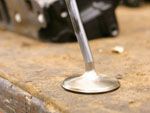
Lots of displacement, more compression, and a ton of valve lift used to be the recipe for a typical professional-level drag-race motor. Today, this same description could just as easily be a serious street engine. If your next motor has a combination including lots of compression and cam, you will need to know how to check valve-to-piston clearance. Today's aggressive cams combined with high-flow cylinder heads thrive on large valve-lift numbers, so even a flat-top piston motor may need some help in the valve-clearance department.
The best way to prevent smacking a valve or two up against a piston is to know exactly what the clearance is before you torque that last head bolt. Let's go through the simple clay method of checking this clearance. Your valves will thank you. So will your wallet.
Cam Timing versus Valve-to-Piston ClearanceThe exhaust valve is generally closest to the piston at 10 degrees BTDC, while the intake valve is generally closest to the piston at 10 degrees after top dead center (ATDC). Given these clearances, it should become obvious that either advancing or retarding the camshaft will result in tighter or looser valve-to-piston clearances. If you anticipate advancing or retarding the cam, you should check valve-to-piston clearance in both scenarios before assembling the engine.
CHANGE RESULT Advance cam timing Decreases intake valve-to-piston clearance, increases exhaust valve-to-piston clearance Retard cam timing Decreases exhaust valve-to-piston clearance, increases intake valve-to-piston clearance VALVE-TO-PISTON SPECS Intake and exhaust: Minimum 0.{{{100}}}-inch depth Minimum 0.050-inch radially Piston dome to head: 0.050-inch minimum* Piston to spark plug: 0.050-inch minimum* *Steel-connecting-rod engines onlyVariables That Affect VALVE-TO-Piston Clearance
Intake centerline (cam position)
Duration
Valve lift
Rocker ratio
Valve diameter
Piston top (domed, dish, or flat)
Shape and angle of piston valve reliefs
Valve angle
Piston deck height
Head-gasket thickness
Valve float at high rpm (loss of spring control)
Pushrod deflection at high rpm
Angle milling heads